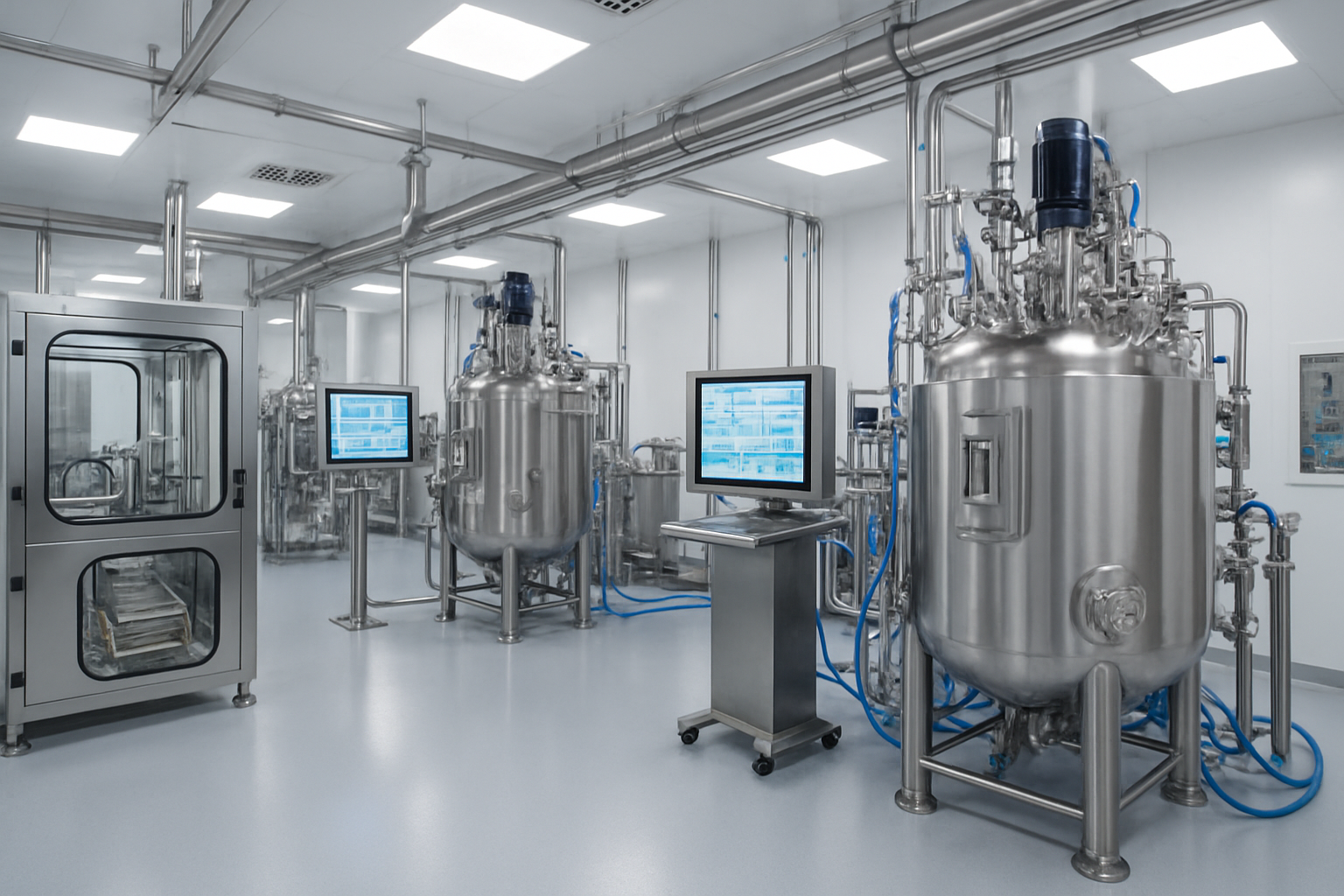National Resilience, a biotech startup that has garnered over $2 billion in funding, is undergoing significant operational changes amid an ambitious vision to revolutionize drug manufacturing. Despite its early promise and backing from leading investors, the company recently announced plans to wind down several of its manufacturing facilities, adjusting its strategy in response to the evolving demands of the biopharmaceutical industry. This pivot is not a retreat but a strategic realignment to concentrate efforts on core competencies and high-demand sectors, notably focusing on the production of GLP-1 drugs, instrumental for treating metabolic disorders and gaining prominence in the pharmaceutical portfolios of giants like Novartis and Eli Lilly.
The biotech sector’s volatility, shaped by fluctuating demand and shifts in regulatory environments, has challenged many startups. National Resilience’s move comes as it continues expanding in high-potential hubs, including Toronto, Ohio, and North Carolina’s Research Triangle Park. These decisions reflect a broader trend seen among industry leaders such as Pfizer, Johnson & Johnson, and Merck, who continually recalibrate their manufacturing frameworks to maintain agility in an unpredictable market.
While certain leased facilities held by an affiliate of National Resilience are undergoing bankruptcy filings, the parent company clarifies that it remains operational and funded, having secured an additional $250 million from existing investors. This financial bolstering aims to fuel innovation and scale production capacities aligned with market needs, promising to deliver over 200 million drug units across multiple modalities and therapeutic areas by 2025. As competition intensifies with established companies like AbbVie, Roche, and AstraZeneca pushing forward with their own manufacturing expansions, National Resilience’s recalibration could serve as a vital lesson in adaptive perseverance in pharmaceutical biotech manufacturing.
National Resilience’s Strategic Facility Consolidation Amidst Industry Challenges
National Resilience’s announcement to wind down six facilities scattered across California, Massachusetts, and Florida represents a major shift in its operational footprint. This decision is driven by the reality that the company’s rapid capacity expansion has outpaced actual industry demand, underscoring the ever-changing landscape of biotech manufacturing. Overexpansion can lead to inefficiencies, elevated operational costs, and underutilized assets, compelling companies like National Resilience to take decisive action.
The facilities earmarked for closure were part of an aggressive growth strategy aimed at capturing significant market share in drug development and manufacturing. However, the biotech sector’s fluctuating demands, coupled with changes in commercialization timelines and regulatory hurdles, have led to a recalibration of capacity needs. By streamlining operations, National Resilience is focusing on its most productive and promising sites in Toronto, Philadelphia, and Cincinnati, as well as in the Research Triangle Park region of North Carolina.
Impacts of Facility Wind-Down on Workforce and Local Economies
While scaling back facilities, National Resilience is facing tough realities regarding workforce reductions and impact on local economies. The closure of these plants inevitably leads to layoffs and disrupts local employment landscapes, which may affect thousands of employees and contractors. Yet, maintaining inefficient facilities could have broader downsides, harming long-term innovation and sustainability. Thus, the company is balancing immediate economic impacts against strategic viability.
- Closure of six facilities in coastal hubs and their operational impacts.
- Retention of manufacturing capabilities in critical centers like Ohio and Toronto.
- Focus on GLP-1 drug manufacturing to secure stable revenue streams.
- Efforts to mitigate layoffs by filling new jobs at expanding sites.
In line with this operational recalibration, there is a broader industry context where pharmaceutical giants including Sanofi, Bristol-Myers Squibb, and GSK are similarly reviewing their manufacturing footprints. These companies are integrating technology-driven efficiencies and geographic consolidations to meet changing market demands with flexibility and cost-effectiveness.
| Facility Location | Status | Primary Focus | Number of Employees Affected |
|---|---|---|---|
| California | Winding Down | Drug Substance Manufacturing | Approx. 400 |
| Massachusetts | Winding Down | Biopharmaceutical Operations | Approx. 500 |
| Florida | Winding Down | Regulatory Support & Manufacture | Approx. 300 |
| Ontario (Canada) | Continuing | GLP-1 Drug Production | Approx. 600 |
| Ohio | Expanding | Clinical and Commercial Drug Manufacturing | Increasing by 440 jobs |
| North Carolina (Research Triangle Park) | Continuing | Commercial Manufacturing and R&D | Steady |

Financial Engineering and Capital Strategy in the Wake of Expansion
National Resilience’s financial maneuvers shed light on innovative capital strategies amidst challenging manufacturing expansion. An affiliate company controlling leases on six manufacturing sites has filed for bankruptcy, a move aimed at shedding burdensome lease obligations. However, the parent company is not filing for bankruptcy and continues its core operations unabated. This approach reflects prudent financial management, allowing National Resilience to recalibrate without undermining investor confidence or operational integrity.
The company has successfully unlocked an additional $250 million from existing investors, signaling continued faith in its transformative vision. This infusion is targeted towards expanding drug product manufacturing capabilities, particularly in high-demand areas such as GLP-1 therapeutics, which attract significant interest among pharma leaders like Roche, AstraZeneca, and Merck. By leveraging this capital, National Resilience aims to scale its drug product network to over 200 million units annually by 2025, accommodating multiple therapeutic modalities including biologics and small molecules.
Balancing Growth with Industry Demand: Lessons from National Resilience
The biotech landscape is characterized by rapid innovation cycles but inconsistent manufacturing demand. National Resilience’s experience highlights the importance of aligning capacity growth with actual market needs, a lesson other pharmaceutical companies such as Pfizer and Johnson & Johnson have learned through their own expansions and contractions.
- Strategic bankruptcy of lease affiliate to optimize cost structure.
- Realignment of capital allocation toward promising therapeutic areas.
- Maintaining investor confidence with transparent financial disclosures.
- Scaling manufacturing output cautiously to avoid underutilization.
| Capital Strategy Aspect | Details |
|---|---|
| Lease Affiliate Bankruptcy | Allows shedding of long-term lease liabilities on six underperforming facilities. |
| New Funding Raised | $250 million from existing investors to continue scaling operations. |
| Focus Therapeutic Areas | GLP-1 drugs, biologics, and small molecules in partnership with pharma leaders. |
| Manufacturing Output Goal | Over 200 million units by 2025 across multiple modalities. |
Industry Context: Positioning Among Biopharmaceutical Giants
National Resilience’s trajectory must be understood against the backdrop of a rapidly evolving biopharma manufacturing industry dominated by major players like Novartis, AbbVie, Sanofi, and Bristol-Myers Squibb. These established companies continually invest in sophisticated manufacturing capabilities to meet growing global demand for complex medicines including oncology biologics, vaccines, and metabolic therapies.
Unlike traditional pharma firms, National Resilience aimed to disrupt the manufacturing ecosystem with technology-driven flexibility and integrated supply chains. However, this innovative approach confronts realities such as fluctuating biotech demand, competitive pressures, and regulatory complexities that even giants must navigate.
Collaborations and Competitive Dynamics
The manufacturing landscape in 2025 is shaped by collaborations, such as partnerships between biotech manufacturers and pharmaceutical companies. National Resilience’s focus on GLP-1 drug manufacturing aligns with the needs of companies like Eli Lilly and Novo Nordisk, revealing potential for niche specialization.
- Partnerships with pharmaceutical leaders to produce therapeutic modalities.
- Investments in automated and aseptic manufacturing technologies.
- Competition for skilled workforce in key hubs such as Ohio and North Carolina.
- Government support and funding to bolster domestic drug manufacturing capabilities.
| Company | Manufacturing Focus | Key Strength |
|---|---|---|
| Novartis | Biologics and Cell Therapies | Strong global manufacturing network with digital innovations |
| Pfizer | Vaccines and mRNA therapeutics | Advanced aseptic processing capabilities |
| Johnson & Johnson | Oncology and immunology biologics | Integrated R&D and manufacturing platforms |
| Merck | Small molecules and biologics | Extensive clinical manufacturing expertise |
| AbbVie | Specialty pharmaceuticals | State-of-the-art manufacturing facilities |
| Roche | Personalized medicines and diagnostics | Cutting edge bioprocessing technology |
| GSK | Vaccines and respiratory medicines | Global manufacturing scale with strong quality control |
| AstraZeneca | Oncology and cardiovascular biologics | Integrated supply chain management |
| Bristol-Myers Squibb | Immuno-oncology and targeted therapies | Strong pipeline and manufacturing agility |
| Sanofi | Vaccines and rare disease therapies | Robust manufacturing infrastructure |
Emerging Trends Reshaping Drug Manufacturing
Key industry trends influencing National Resilience’s approach and that of larger drug manufacturers include advanced automation, digital twin simulations for manufacturing processes, and modular facility designs for swift product turnaround. This tech infusion not only enhances efficiency but responds to supply chain uncertainties critical in today’s global landscape.
These developments highlight why National Resilience’s challenge is emblematic of a wider industry recalibration, blending technological promise with operational pragmatism.

Future Outlook: How National Resilience’s Transformation Could Influence the Biotech Landscape
The scaling back and refocusing by National Resilience could serve as a pivotal case study in biotech manufacturing evolution. Its example underlines the critical importance of matching manufacturing growth to precise market needs rather than speculative expansion. Future competitors and partners alike will look closely at how this transformation unfolds.
Additionally, National Resilience’s selective facility retention and expansion in high-demand regions may prompt other biotech startups and contract development and manufacturing organizations (CDMOs) to rethink geographic and strategic positioning. This could lead to a wave of consolidations and redesigns across the industry, especially with pressure from major pharmaceutical companies prioritizing agile manufacturing systems to accommodate fast evolving drug pipelines.
Key Lessons and Strategic Recommendations for Industry Players
- Maintain flexible manufacturing capacity closely tied to realistic demand forecasts.
- Focus innovation investment on high-growth therapeutic areas such as GLP-1 drugs and biologics.
- Innovate capital management, including lease strategies, to reduce financial risk.
- Collaborate strategically with major pharma for stable revenue and market presence.
| Strategic Element | Potential Industry Impact |
|---|---|
| Facility Consolidation & Streamlining | Reduces redundant capacity, optimizes operating costs |
| Capital Restructuring | Enhances financial sustainability and investor confidence |
| Focused Therapeutic Manufacturing | Improves specialization and market responsiveness |
| Strategic Pharma Partnerships | Secures steady demand and innovation collaboration |
FAQ: Essential Questions on National Resilience’s Operational Shift
- Q: Why is National Resilience closing multiple facilities?
A: The company is consolidating operations because its rapid expansion created excess capacity surpassing current industry demand, necessitating a focus on core, high-demand manufacturing sites. - Q: Will National Resilience stop manufacturing altogether?
A: No. The company continues operating several key facilities, especially in Toronto and Ohio, maintaining significant production of GLP-1 drugs and other therapies. - Q: How is National Resilience’s financial position after these changes?
A: National Resilience raised $250 million from existing investors and used strategic financial restructuring, including filing for bankruptcy in a lease-holding affiliate, to optimize operational costs without halting core activities. - Q: What is the significance of GLP-1 drug production in their strategy?
A: GLP-1 drugs are in growing demand for metabolic diseases, aligning National Resilience with major pharmaceutical players like Eli Lilly, boosting its commercial prospects. - Q: How does the broader pharma industry context affect National Resilience’s decisions?
A: The fluctuating biotech manufacturing demand and competition from established companies like Pfizer, Roche, and GSK influence National Resilience to strategically consolidate and innovate its manufacturing approach.


